
|   |

|   |
18th edition of Guru Kelucharan Mohapatra Award Festival Text & pics: Lalitha Venkat, Chennai e-mail: lalvenkat@yahoo.com September 15, 2012 Srjan presented the 18th edition of the Guru Kelucharan Mohapatra Award Festival in Bhubaneswar from September 5 - 9. It never ceases to amaze us that despite his busy schedule, Guru Ratikant Mohapatra, director of Srjan, always manages to find the time to come personally to the airport to receive his festival guests, enquire every day after everyone’s welfare, is all over the venue attending to every single detail, and also stage a new production on the concluding evening. With support from his colleague Debiprasad Mishra and his trusted band of volunteers, the festival was, as usual, conducted most efficiently and with the least fuss. The main aim of the festival is to sustain dance and music culture of India, by inviting distinguished artistes as well as upcoming talent who have not performed in Odisha before. The inaugural evening saw tight security at the Rabindra Mandap for the Governor’s arrival. Coming from electricity-deficient Chennai, it was a pleasure to see the venue fully lit up outside with the added illumination of small applique work cloth lanterns bordering the drive. Two picture panels on either side of the drive caught the images of this festival’s journey through the years. In the lobby were panels of Kelubabu in dance poses and scenes from his life, and a panel of this festival’s artistes. The full hall waited expectantly for the festivities to start after the traditional lighting of the lamp and customary brief speeches by the eminent guests on the dais. So much can be expressed in just a minute and the longest speech was just about 3 minutes or so! To thunderous applause, Hari Shankar Upadhyay, Director, Odisha Tourism, pointed out that the day being Teacher’s Day, it was really apt to start the festival dedicated to one of the greatest teachers of Odissi. Ashok Kumar Tripathy, Principal Secretary, Tourism & Culture, lauded Guru Kelucharan Mohapatra for bringing back to life, a dance form that had been to all purposes, frozen on the temple walls. Shri Muralidhar Chandrakant Bhandari, the honorable Governor of Odisha, said art is the language of the heart. Attending this fest for the third time, he recalled how at every given opportunity he had watched Kelubabu perform in various cities across India. “When I came to Orissa, I found it not only the most beautiful place, but also the most musical place. I’ve rarely seen a guru like Kelucharan Mohapatra. Dance was his sadhana and teaching was his dharma. I have very fond memories of him and I am extremely happy to inaugurate the festival.” The entire auditorium was decorated with craft items of Odisha. The aesthetically designed stage backdrop had one large photograph of a seated Kelubabu with arms stretched out set inside an arch in the centre and a frieze of elephants running along the base. On either side, two columns in the front and one at the back was the only other embellishment compared to last year’s elaborate stage decor. A serene Odissi performance by the petite Madhavi Mudgal clad in dark pink costume with purple border was the first presentation of the festival. Jagannath Ashtakam written by Shankaracharya was followed by “Ea ghana kalare” by poet Upendra Bhanja set to raag Desh about the nayika Radha separated from her beloved due to ego issues. She wonders if another woman is holding the attention of her man. The dance of the peacock, chirping of birds and the beauty of nature around her induces loneliness and yearning to be with her beloved. Celebrating pure dance movements, Pallavi was in raag Jhinjhoti. Madhavi concluded her performance with a bouquet of excerpts from 3 ashtapadis (Madhave ma kuru manini manamaye, Kshana madhuna Narayana manugatam, Kuruyadunandana) composed by Pt. Jasraj, Madhup Mudgal and Bhubaneswar Mishra respectively about a sakhi telling Radha to give up her pride and go back to Krishna, a repentant Krishna showering Radha with attention and the final reunion of the couple, the last being a choreography of Kelubabu. The music of the 3 stalwarts was absolutely soulful and an aural treat. The distinguished orchestra had Gandhi Mallick on pakhawaj, Poornachandra Maji and Manikuntala Bhowmick on vocal, Srinibas Satpathy on flute, Yaar Mohammed on sitar and Arushi Mudgal on manjira. Having just recovered from a bout of flu, Madhavi’s sensibly paced and elegant recital was a good start to the festival. 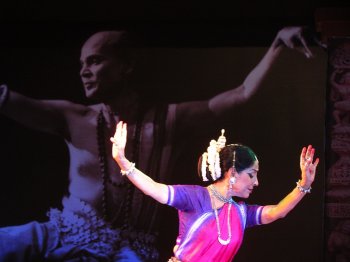 Madhavi Mudgal 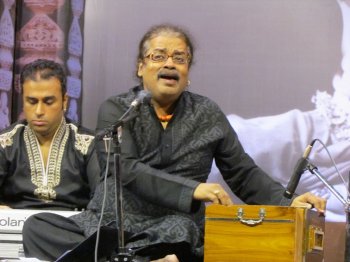 Hariharan Accompanied by Pradeep Pandit on harmonium, Shadab Bharatiya on tabla and Zohar Hussain on keyboard, popular singer Hariharan entertained us next with ghazals like Aandhiyaan aathi thi, kaash aisa koi manzil hotha, aks chehere pe, ranjish hi sahi which he dedicated to Mehdi Hassan, kesariya baalam vaa, nagme hai, patta patta, main khyaal hoon kisi aur ka. His Indian / western style elaborations in kudh ko padtha hoon, he likened to “the Urdu blues!” Being also a popular playback in films, the audience wanted some film songs and he obliged with a couple. The Bhubaneswar audience is always participatory in music programs and here they were singing along, keeping the beat and enjoying Hariharan’s witty remarks that he interspersed through his concert. What was a bit distracting was his leafing through about half a dozen black files every now and then! The morning of September 6 was spent at the beautiful Orissa Government Museum set amidst lovely green lawns. The archaeology section was of special interest to us with its beautifully displayed sculptures of Buddhist and Hindu pantheon. The hairstyles, necklaces and anklets on some were gorgeous. The bronze gallery, manuscript gallery, Orissa craft gallery were also interesting. And the entrance fee is a mere Rs.5. 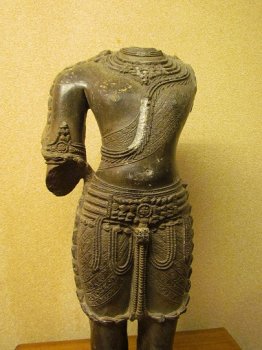 Vishnu 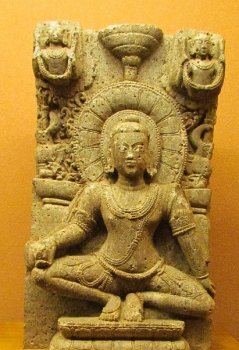 Bodhisatva We got the opportunity to meet Chitta Ranjan Mallia, the dynamic Secretary, Odisha Sangeet Natak Akademi, who gave us a lot of information in the few minutes we spent at his office. He said there are 328 folk art forms that are being presented but there are so many more that are in danger of becoming extinct. How to get the younger generation interested in these arts is a problem. Workshops should be conducted, further training arranged and it should all be systematized. Earlier, gotipua style was looked down upon, but gurus like Maguni Das continued to do their best to keep the tradition alive, apart from tending to their own livelihood. Lot of music was also used in early Gotipua performances and traditional songs of medieval poets. There was more dance and less of acrobatics but now it is the other way around, perhaps to hold audience attention. With so much of acrobatics, Gotipua performances have become crowd pullers. There also used to be a significant element of abhinaya in gotipua style, something rarely seen these days. With the Tourism department introducing so many new dance and music festivals, is there an audience for all this? There is generally very good crowd, especially for the folk art forms that is very encouraging. Mr. Mallia feels in the last 2 years, festivals are being better organized, with more aesthetics and ambience, but concentrating all festivals in Bhubaneswar is not beneficial and so festivals have to be scattered for creating cultural awareness around the State. He feels nothing can be better than watching performances in the very area where that particular art form flourishes and performers are concentrated. A drive to Cuttack post lunch was a flop due to an accident. There was an anti-Coalgate rally in Bhubaneswar and police used lathi charge to disperse the crowd. The SUVs and cars carrying the protestors were returning after a bad day and hence the road was full of these bad drivers in bad mood as we made our way to Cuttack just 28 km away. As luck would have it, one of the cars rammed into our car from behind, jolting us in the middle of a super funny anecdote! And another car hit the car that hit our car…total pandemonium for the next half hour. And all this despite our cab driver having flung out a rupee coin from the car on to an old small Devi temple by the roadside (It is very old. How old is very old? 30 years old!). Would not anybody and everybody pick up these coins? He is confident they will be picked up by only one person and no one else! While passing through narrow lanes trying to locate an address (which we ultimately did not), we saw highly ornate facades of modest homes. A rather pleasant accident! The evening performance started with a Kuchipudi recital by an ill Manju Barggavee, a senior disciple of Guru Vempati Chinna Satyam. Manju depicted Radha remembering the times she spent with Krishna and feeling jealous about his spending time with other gopikas in the ashtapadi “sanchara dadhara” followed by Lekha, the letter written by Satyabhama to her lord, pouring out her anguish of separation. She danced on the brass plate to “Maragadha mani,” a composition of Oothukadu Venkata Subbaiyer in Arabhi ragam. To add to her misery, the tall and stately dancer was also plagued by bouts of coughing. While one saw occasional flashes of her brilliance, dancing clearly exhausted her (at one point we thought she would faint) but she valiantly did her super best in the second half of her performance. She received good support from Sudhir Rao on nattuvangam, KR Sudharani on vocal, V Sridhar Acharya on mridangam, Palaparty Anjaneyulu on violin, S Kumar Babu on flute. 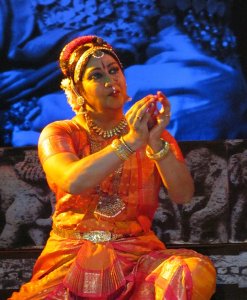 Manju Barggavee 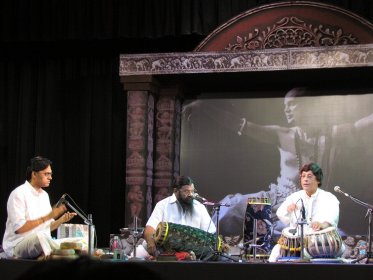 Amrit, Kaaraikkudi R Mani, Pt Anindo Chatterjee The percussion tala vadya kutcheri featured maestro Kaaraikkudi R Mani on mridangam, Pt Anindo Chatterjee on tabla and Bangalore Amrit on a loud kanjira. Guru Mani recalled that 30 years ago, he had travelled with Kelubabu to Hungary and had a lot of interaction with him regarding rhythm sections, because Kelubabu was not only a great dance teacher but an acclaimed pakhawaj player as well. Playing “pure classical style in 8 beats,” their fingers literally flew over the mridangam and tabla and the elaborate sequences were so varied that it sometimes seemed like more people were playing. While the talent of the kanjira player was never in doubt, his asking for the volume level to be raised not once but 3 or 4 times, did not help and it ended being more an assault on the eardrums than a musical experience. The Bhubaneswar audience really loves music and the full house attested to that. 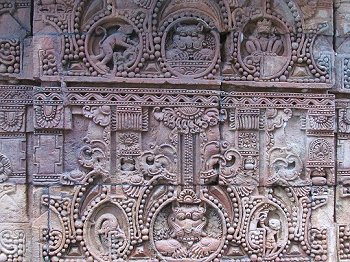 Parasurameswar temple 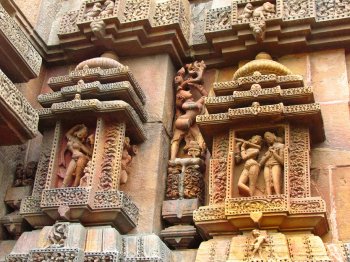 Brahmeswar temple September 7 turned out to be a cloudy day with intermittent rains. We revisited the beautiful temples of Bhubaneswar. Since our visit last year, the famous Lingaraja temple remains embarrassingly dirty and the priests as aggressive as ever. In Mukteswar, Brahmeswar, Parasurameshwar, Raja Rani, Lakshmaneswar group of temples, one never tires of admiring the beautiful sculpture and wonder about the talented craftsmen who had fashioned such exquisite figures and designs in stone. Surrounded by lush green lawns, the ASI is maintaining these monuments well but care could be also spent in disposing off rotting flowers in sanctums! Rasikas, including the Governor, turned out in full strength to see the stunning Vyjayanthimala Bali present a Bharatanatyam recital. The septuagenarian dancer said she was happy for the opportunity because Kelubabu had invited her to the city to perform but it had somehow never materialized in his time. She commenced with an invocation to Ganapati, a composition of Muthuswami Dikshitar, followed by a keertanam “Sivagamasundari” by Gopalakrishna Barathi in Jaganmohini ragam. The varnam “Sumasayaka” of Swati Thirunal in Kapi was about the yearning of a beautiful maidan wishing to be united with Lord Padmanaba after being smitten by the arrows of Manmatha. 'Tarangini' by Narayana Teertha showed Krishna dancing playfully with the gopis and the concluding item was shuba mangalam in Vasantha ragam seeking the blessings of Goddess Amba. She concluded by prostrating before the image of Kelubabu and the rapt audience burst into applause. The audience was totally smitten by Vyjayantimala's pure classical Bharatanatyam, her charming abhinaya, her elegant movements with deep bends and araimandi, turns and stretches that would put a dancer half her age to shame. She remained fresh through her recital, with absolutely no slackening of energy. It was stunning to see her exceute what looked like a chowka position that we had been admiring in a sculpture just that morning at Parasurameswara temple! According to a local press report, "she set the stage on fire!" For many in the audience, it was a dream come true to see the icon perform. No wonder she got a standing ovation. The wonderful accompanying musicians were young Anahita Ravindran on vocal (trained by Bali herself), Gayatri Sashidharan on nattuvangam, Sriguru Bharadwaj on mridangam, and Chaitanya Kumar on flute. The one disheartening note was spotting veteran dancer Kumkum Mohanty, struggling to find a seat in the packed hall, especially since she was the recipient of last year's Kelucharan Mohapatra Award. 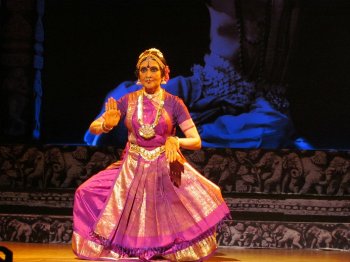 Vyjayantimala Bali 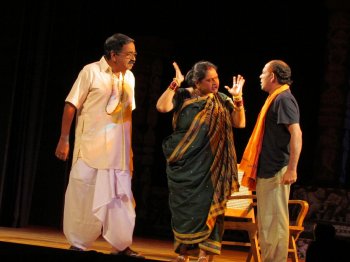 Bahana Since Kelubabu had been involved in dance, music, film and theatre, the decision was taken to include an Odiya play for the first time in the festival. 'Bahana' showcased the social issues related to an Odia family. Directed by Jayadev Das, who was returning to theatre after 20 years, the play was originally written by noted Hindi writer Ramesh Mehta and translated by Amiya Bala Mishra. The audience was in splits and though it was in Odiya, we could understand the dialogues in context and contrary to expectations, we enjoyed the play as much as the local enthusiastic audience. All the actors were good and their comedy timing and dialogue delivery impressive, but the woman of the family was definitely the most colorful character. Two officers of the ASI (Archaeological Survey of India) graciously took time to accompany us to the Buddhist sites of Lalitagiri dating to 1st century AD and Ratnagiri a couple of hours drive from Bhubaneswar the next morning. The small museum at Lalitagiri has some wonderful sculpture from the area and photography of the artifacts is not permitted. There are the remains of a chaitya hall, many votive stupas and a large brick monastery. A renovated brick stupa atop a hillock is reached by a flight of steps from where it is green as far as the eye can see with distant hills. 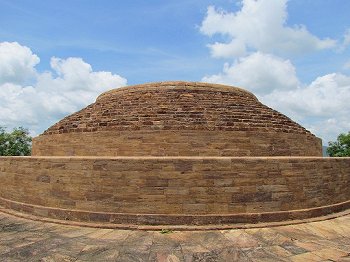 Stupa at Lalitagiri 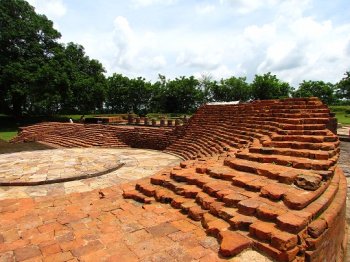 Chaitya hall at Lalitagiri 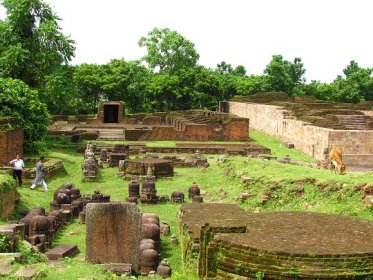 Ratnagiri 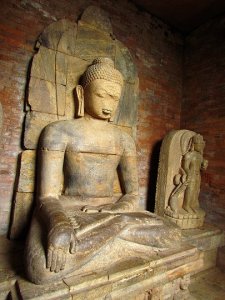 Ratnagiri Ratnagiri by the River Birupa flourished from 6th to 12th century AD. In the beginning, it was an important center for Mahayana Buddhism, later becoming a center for Tantric Buddhism in the 8th and 9th centuries. We were told these sites were discovered only in the 1980s. The Buddhist shrines, monasteries, votive stupas and sculpture pieces are being well maintained. Many sculptures found at the site are housed in an adjacent spacious museum. However, something should be done to stop locals from grazing their cows and goats in this site amidst such ancient monuments. Last year, all surroundings had been totally submerged in flood water except for the road. It was a pleasure to see the green landscape this time. The recently opened Toshali Resort by Odisha Tourism just across the road is convenient for having food as well as for stay. The evening witnessed a fusion of Indian classical, western and Arabic music by talented duo Paras Nath and Pankaj Nath on flute, sons of eminent flute maestro Amar Nath. They were accompanied by Atul Raninga on keyboard, Vinayak Netke on tabla and Darshan Doshi on drums. The group played a number from their recently released album ‘Eternal Winds’ and numbers in raag Kirawani, Pahadi, Hamsadhwani, an item that had Arabic influence for which a traditional north Indian flute was modified, a padant with Sufi touch that they dedicated to Guru Kelucharan Mohapatra as his disciples. The soulful finale “miley sur mera tumara” was definitely the highlight of their recital with the audience keeping beat and humming along softly. A rasika found the performance “high octane and mind blowing!” The audience surely had a soft spot for these talented youngsters. What shocked rasikas however was Odiya flautist Mohini Mohan Pattnaik walking to the edge of the dais, wagging his finger at the young flautists even as they were playing the last number and berating them for something in public - totally uncalled for.  Vinayak Netke, Paras Nath & Pankaj Nath 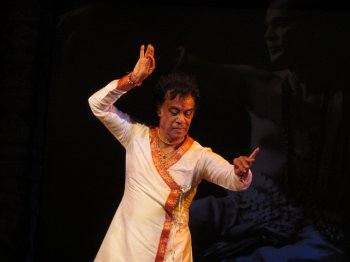 Pt Chitresh Das US based kathak maestro Pandit Chitresh Das was performing in Bhubaneswar for the first time. He was accompanied by Viplav Bhattacharya on tabla, Jayanta Banerjee on sitar, Debashish Sarkar on vocal, Seema Mehta on manjira and Abhiram Nanda on flute. Das commenced with a highly energetic Dance of Shiva and the frenetic pace lasted through the recital. Instead of doing the usual recitation of bols and demo, he showed us some pure dance with bols of Jaipur and Lucknow styles, and an enchanting episode from the Shakuntala and Dushyanta story where the veera rasa of the hero coming riding on a horse contrasted with the coyness of the heroine. The highlight of his recital was depicting the many sounds of a train with steam engine, as it picks up speed, approaches a train station, arrives and departs from the platform, passes an electric train, goes over a bridge etc. It was a difficult piece as the sound changes according to which part of the foot strikes the floor. It was a riveting display of control over footwork. Chitresh Das then presented his unique Kathak Yoga (“inspired by sadhu sanyasis”) that he is known for. He played the tabla in different speeds, singing as well as executing footwork, all at the same time. The recital concluded with Chaitanya Prabhavam. The only slow down in his fast paced recital (very commendable at his age) was when he had to adjust his slipping churidar folds above his ankle bells between items. The finale of the festival saw the Guru Kelucharan Mohapatra Award for 2012 being conferred on Guru Birabara Sahoo (Gotipua dance guru) and Rama Chandra Pratihari (Odiya theatre and cinema) by the Odisha Chief Minister, Shri Naveen Patnaik. The award carries a purse of Rs.50,000 with a memento and citation. The award was instituted in 1995 by Ratikant Mohapatra with a view to generate a feeling of cultural amity amongst the performing arts fraternity and acknowledging the excellence and contribution of great artists in the field of dance, music, theatre and cinema. Ashok Kumar Tripathy, the dynamic Principal Secretary of Odisha Tourism, quoted Protima Bedi’s stirring words about how she came to Guru Kelucharan Mohapatra as a disbeliever in spirituality and falling at someone’s feet, and how she got transformed voluntarily while training under him. 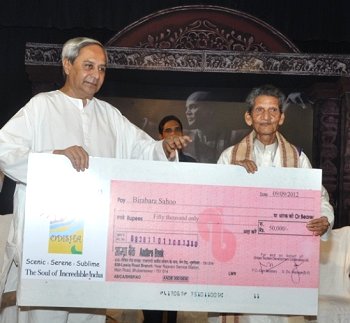 CM gives award to Birabara Sahoo 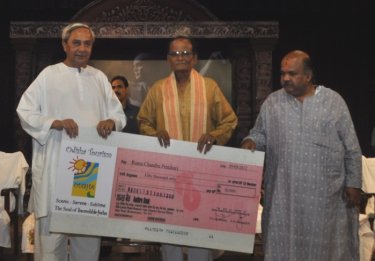 CM, Rama Chandra Pratihari, Maheshwar Mohanty (Minister for Tourism & Culture) Pics courtesy: Srjan
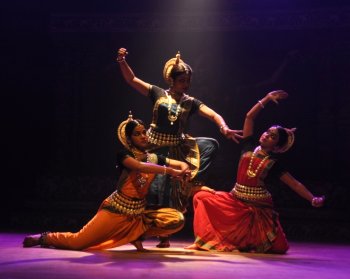 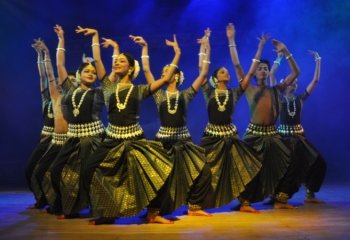
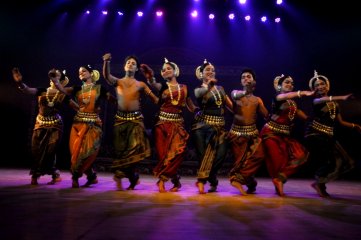
Then came the much awaited performance by the well trained Srjan Repertory that presented three items, all beautifully choreographed by Ratikant Mohapatra. “Bho Shambo” by Dayanand Saraswati described the different atributes of Lord Shiva. “Ananda Lahiri Devi Vandana,” an offering to Mother Goddess based on the composition of Shankaracharya was set to music by Debasish Sarkar. Every year, Srjan premieres a new production for the festival and this year, it was a neo classical work titled ‘Bishwas’ (faith) with music composed by Laxmikant Palit. Utilizing images from Christianity, Hinduism and Muslim faith, verses from Gurbani for voice of the people and poetry of Sant Kabir for the voice of god, the piece explored search for truth and the immense power of faith. While the people say that god is in Hindu, Muslim or Christian places of worhsip, god answers that to anyone who believes, god is with him. Easily identifibale movements like sufi twirl, a man carrying a cross were all integrated into the Odissi medium. Ratikant has also used a particular signature movement throughout the piece. The costumes for this item were in black and silvery gray, in contrast to the colorful costumes for the previous numbers. Usage of rather colorful lighting sometimes made it hard to discern the facial expressions but one must commend the committment of lighting expert Jayadev Das whose father had passed away that very morning. Das completed the last rites and honored his program commitment to Srjan. The gathering stood in silence as a mark of respect to the departed soul. The program was compered by the experienced Sadhna Shrivastav on all days. Pt Raghunath Panigrahi, who was seen enjoying all the programs every evening, blessed the artistes and gave away the mementoes. Through the festival, performers and invited guests received a set of beautiful books from Orissa Tourism. One must congratulate Srjan for continuously keeping up the tradition impeccably for the past 18 years and at the same venue for which the caretaker of Rabindra Mandap was honored. One drawback is the low one foot wall bordering the fringe of the stage which makes it difficult for us to see the footwork, which is so important in all dance forms, especially Kathak, if the artiste performs in the front half of the stage. Maybe artistes could adjust accordingly to the performance space! It is not easy to organize a festival in Odisha. Apart from whims of performing artistes, the organizer must also contend with some aggressive press persons who do not want to observe basic etiquette required of them. While their tendency to chatter loudly with each other as well as on the cell phone has now reduced considerably, they insist on still blocking the view for spectators, taking flash photos, taking photos and video of audience when performance is going on, rather disturbing and distracting for both performer and spectator. When gently told not to, they resorted to complaining aggressively to Ashok Kumar Tripathy on the fourth evening after the fusion music in full view of the audience and absenting themselves for the last day when only 3 or 4 press people turned up, making for a rather peaceful evening! Maybe it is time photo and video journalists are put through a course to enlighten them on concert etiquette. With so much hard work put into organizing a festival of this magnitude, one wishes Srjan a smoother sailing next year. View Slideshow of Dr. Vyjayanthimala Bali at the 18th Guru Kelucharan Mohapatra Award Festival on September 7, 2012 at Bhubaneswar 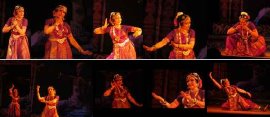 Photos: Lalitha Venkat & Arabinda Mahapatra Slide show: More pics of the festival  Photos: Lalitha Venkat Lalitha Venkat is the content editor of narthaki.com |